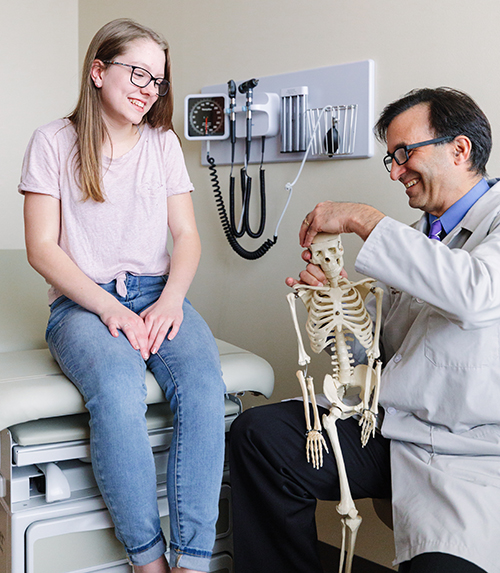Have a stronger backbone, literally
May 15, 2019
Q & A with Benjamin Hasan, M.D., NCH Medical Group Sports Medicine and Primary Care Physician, and Medical Director of the NCH Back and Spine Clinic

Many people suffer from back pain, neck pain, or pain that radiates down the side of the body into the leg. Dr. Hasan explains three things you can do to keep your spine healthy and ways in which the NCH Back and Spine Clinic can help.
How can you tell if patients have spine problems?
When we see patients, we listen to them describe their symptoms, take their medical history and examine them to look for bone problems, pain when we push on the bones, or soft tissue redness or swelling. We get diagnostic information from this thorough exam, and additional information from imaging, which can include a variety of things such as X-rays, MRIs, CT scans and ultrasounds. We can come up with a very specific diagnosis using these three methods – medical history, examination and imaging.
How does your Sports Medicine specialty help when treating patients suffering from back pain?
In addition to being board-certified in Primary Care, I’m board-certified in Sports Medicine, a separate specialty that has been recognized in the United States for 30 years. Sports Medicine specialists are trained in the evaluation of muscles, joints, injuries and illnesses that affect athletic people, and they do a good job of treating patients with problems that affect their spine, neck and back.
What are some ways people can improve their spine health?
Patients can be active in three different ways:
- They can work on stretching and flexibility.
- They can improve their strength. Very often, this can be done with resistance exercises such as weight lifting.
- They can improve their endurance, which is aerobic cardio activities such as running on a treadmill, swimming, cross country skiing and biking.
What is sciatica pain and how is it diagnosed?
The medical term is radicular lumbar pain: low back pain that radiates from the back to the side and down the leg.
We listen to how patients define the pain. If someone has broken his back, we’ll know that because pushing on his vertebrae column is going to be very painful. If someone has redness and fluid in the spine and a fever, the exam is generally geared toward looking for an infection. In addition, X-rays would be taken to make sure there aren’t any broken bones.
In the short term, we can treat radicular lumbar pain with safe medications, ice, heat, stretching, simple fitness exercises at home and physical therapy. We rely heavily on trained physical therapists to show patients what they should and shouldn’t be doing. In most cases, symptoms will improve. If not, then we can get an MRI scan which may show bulging discs, fragments of bone or tumors.
Are nerves involved with this type of pain?
A lot of patients have pinched nerves, and when we hurt, the communication to our brain is through our nerves. We have to find treatable causes of back pain, and that is often a muscle strain or spasm pain. Once we can correct that, the nerves are happier.
Find out more about the NCH Back and Spine Clinic.
Patients can schedule an appointment with or without a referral from their primary care physician. Call 847-725-8401.